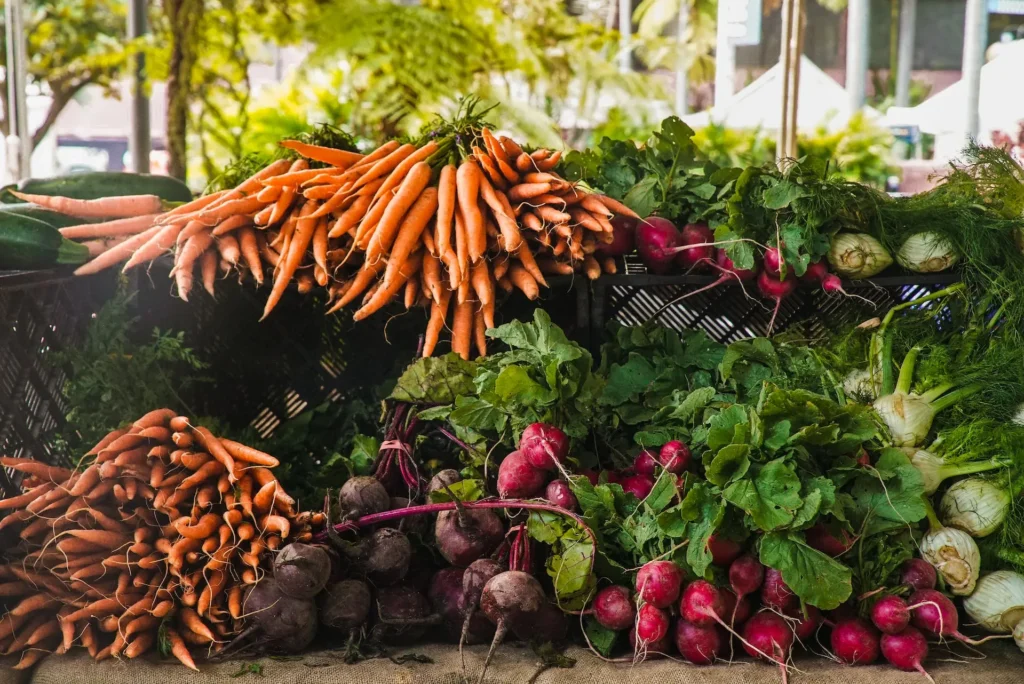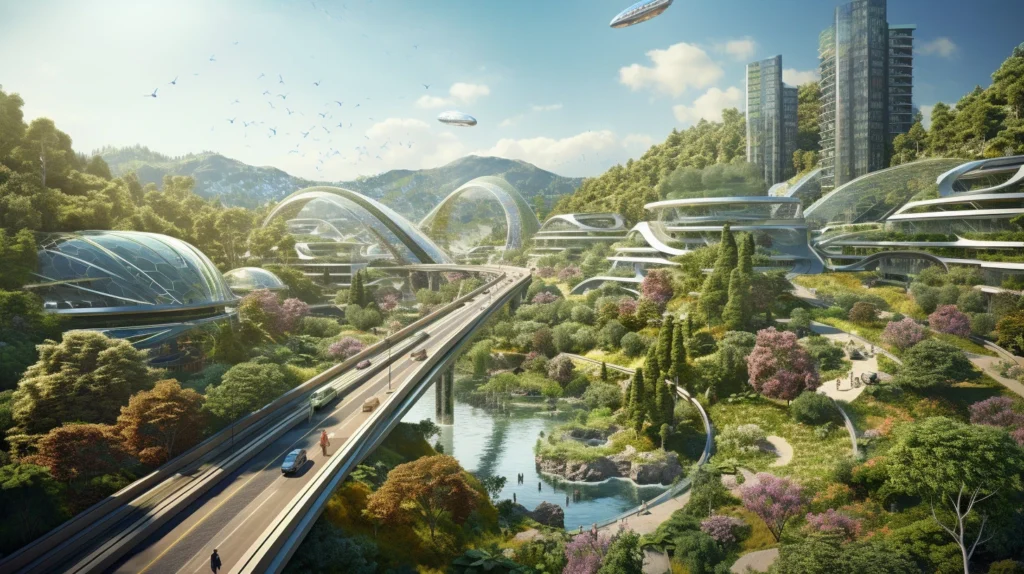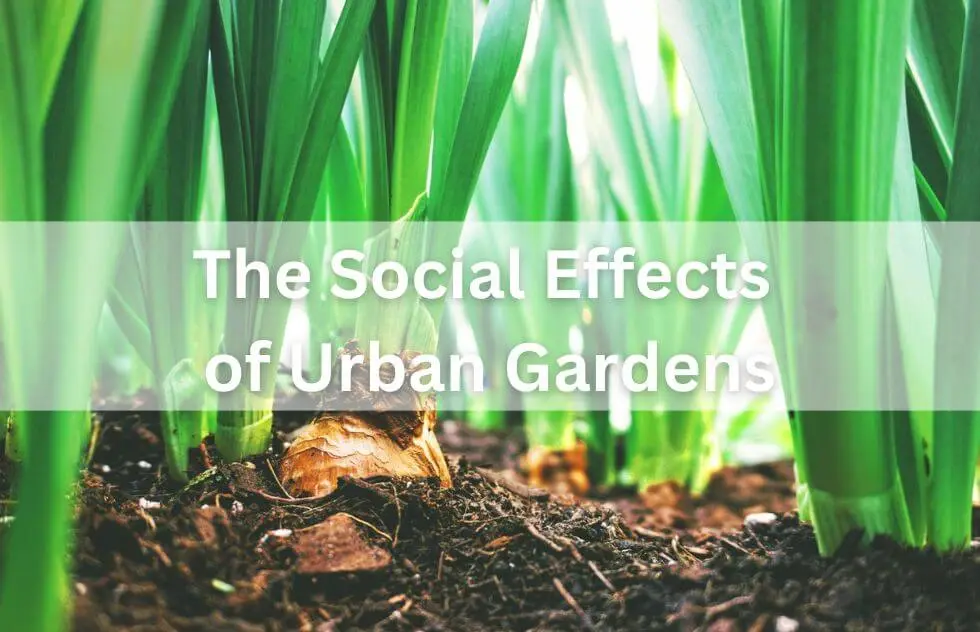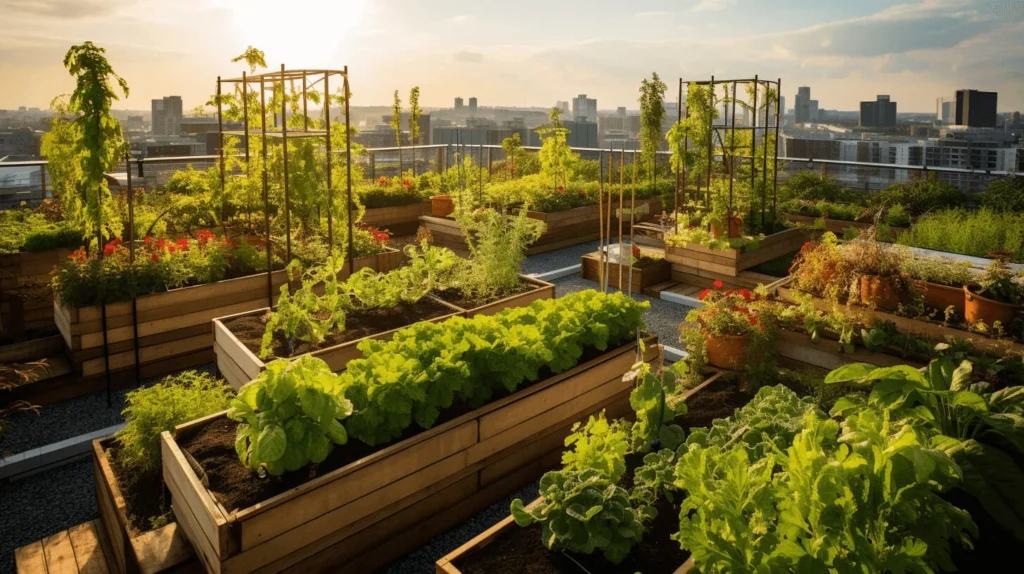Climate change, rising food prices, and a growing awareness of healthy eating are fueling a movement that is transforming cities around the world: urban gardening.
At a time when our supply chains are more vulnerable than ever, people are seeking local solutions—and finding them right on their doorstep.
Urban gardening, the practice of growing food in urban spaces, is closely tied to the idea of sustainable nutrition. It brings people together, creates green oases, and empowers city dwellers to take control of their own diets.
In this article, we’ll explore what lies behind the concept, why it’s socially relevant, and how anyone can contribute—regardless of where they live, how much space they have, or how much experience they bring.

What Is Urban Gardening, Really?
Definition and Origins
Urban gardening is far more than just a pleasant hobby. It’s a movement, a political statement, and a response to some of the most pressing questions of our time: How do we want to feed ourselves in the future? How can we make meaningful use of limited urban space? And how can we bring nature back into our cities?
In concrete terms, urban gardening means cultivating fruits, vegetables, herbs, and flowers in urban areas—consciously growing food amidst concrete and asphalt. It can take place in backyards, on green rooftops, in community gardens, on vacant lots, or even along building walls. The goal isn’t just to provide people with food, but also to revitalize urban spaces in ecological and social ways.
Urban gardening has its roots in various historical contexts. As early as the 19th century, so-called “Schrebergärten” (allotment gardens) emerged in German cities, giving working-class families access to fresh air and healthy food. During World War I and II, “Victory Gardens” were planted in many countries to help ensure food supplies. In the economic crisis of the 1990s, Havana became a pioneer of urban agriculture, establishing thousands of small farms right in the heart of the city.
Today, urban gardening is experiencing a renaissance. Driven by a desire for sustainability, autonomy, and community, city dwellers are finding creative ways to turn urban spaces into green oases.
Forms of Urban Gardening
Urban gardening takes many shapes—ranging from individual to collective efforts, and from legal to subversive initiatives:
- Community Gardens: Residents work together to cultivate a shared green space. These gardens are often open to the public and serve not only for growing food but also as hubs for social exchange. They create spaces for connection, neighborhood engagement, and education.
- Rooftop Gardens: Whether on schools, supermarkets, or office buildings, flat rooftops are used to grow edible plants. This makes use of previously unused space and also improves the urban climate by reducing heat and storing rainwater.
- Vertical Gardens: When horizontal space is limited, gardening moves upward. Plants grow on walls, fences, or specially designed vertical modules, making this an innovative solution for densely populated urban areas.
- Guerilla Gardening: This subversive form of gardening transforms vacant lots or traffic islands into green zones—often without official permission. It’s also a form of protest: against soil sealing, against urban planning without citizen participation, and for the right to nature in public spaces.
- Balcony and Indoor Gardening: Even in the smallest of spaces, gardening is possible. From pots on a windowsill to vertical herb walls in the living room or small hydroponic systems, urban gardening can be practiced individually and flexibly in any apartment.
This diversity shows that urban gardening is not a single method but an open movement with many approaches. It can be adapted to the unique possibilities, needs, and ideas of people in each location.

Why Sustainable Nutrition Is an Urban Issue
The Challenges of the Global Food System
Our current food system is designed for efficiency and mass production—with visible consequences: supermarkets are well-stocked, food is relatively cheap, and the variety is vast. Yet behind this apparent abundance lies a highly fragile and environmentally damaging system.
One of the key problems is long transportation routes. Tomatoes from Spain, apples from New Zealand, beef from Argentina—this globalization of our plates causes enormous CO₂ emissions. Transportation accounts for a significant share of the environmental impact of food production—especially when refrigeration or air transport is required.
A large portion of packaging waste also stems from industrial food production. Plastic trays, films, styrofoam, and single-use packaging usually end up in the trash—or worse: in the environment. Even recyclable materials are not always disposed of correctly. The result: polluted cities, contaminated oceans, and microplastics in our bodies.
Then there’s the issue of food waste: about one-third of all food produced globally is never eaten. The reasons include overproduction, improper storage, trade standards, and consumer habits. Meanwhile, hundreds of millions of people go hungry—this is both a moral and logistical failure.
Another major concern is the dependence on monocultures and a few large corporations. Global agriculture is dominated by just a handful of crops—such as corn, wheat, and soy. These systems are vulnerable to pests, disease, and climate shocks. In addition, they degrade soil and water systems through excessive fertilization and pesticide use.
Taken together, it becomes clear: our current way of eating is neither ecologically nor socially sustainable. That’s why sustainable nutrition isn’t just an option—it’s a necessity. And it starts where most people live: in our cities.
Urbanization and Food Security
Cities are growing rapidly. Today, more than half of the world’s population lives in urban areas, and by 2050, that number is expected to rise to around 70 percent. As a result, the issue of food security is increasingly shifting from rural areas to cities. However, urban environments are rarely designed with food systems in mind.
Many neighborhoods—especially in low-income areas—are known as “food deserts”: places where fresh, unprocessed food is difficult or impossible to find. Instead, these areas are dominated by fast food chains, gas station shops, and discount stores overflowing with heavily processed products. The result is poor nutrition, obesity, diabetes, and other lifestyle-related diseases—not due to a lack of choice, but a lack of healthy options.
At the same time, urban infrastructures are heavily dependent on external supply chains. Logistics networks, supermarket warehouses, and global trade routes ensure a steady flow of goods—but they are vulnerable to disruption. Pandemics, wars, extreme weather events, or trade conflicts can all threaten supply. This has become evident through the COVID-19 crisis, the war in Ukraine, and droughts in southern Europe.
In light of this, local food sovereignty is gaining importance. Cities that produce their own food—or at least promote local food systems—are better equipped to handle crises. They reduce dependency and build resilience.
Furthermore, food is increasingly being seen as a political issue. Who decides what gets eaten? Who has access to fresh food? And who profits from the current system? Sustainable urban nutrition is therefore also a matter of justice, participation, and social transformation.

How Urban Gardening Supports Sustainable Nutrition
Urban gardening is not just a way to grow your own vegetables—it’s a concrete contribution to the ecological and social transformation of our food system. Through local production, mindful cultivation methods, and community-based structures, urban gardening achieves far more than is immediately visible.
Regional and Seasonal Eating
One of the most important contributions to sustainable nutrition is the drastic reduction of transport distances. Instead of shipping food across thousands of kilometers, it is grown where it’s consumed—right in the city. This means less CO₂, less packaging, and fewer intermediaries.
Urban gardeners harvest according to the season, because only what suits the local climate will grow. This leads to a better understanding of natural growth cycles: strawberries in June, tomatoes in high summer, and kale after the first frost. This reconnection to nature’s rhythm fosters awareness and appreciation—an attitude often lost in the supermarket setting.
In addition, fresh, homegrown food is more eco-friendly, healthier, and more flavorful. Since it doesn’t require long storage or industrial processing, the nutrient content remains high and the taste is pure.
Promoting Ecological Growing Methods
Another key aspect of sustainable nutrition is the avoidance of harmful chemicals—a goal that urban gardening naturally embraces. Since it usually involves small plots tended by individuals or communities, the use of pesticides is uncommon—and would also pose health concerns in such close proximity.
Instead, nature-friendly techniques are commonly used:
- Composting replaces synthetic fertilizers and closes local nutrient cycles. Kitchen scraps are transformed into valuable humus.
- Rainwater harvesting conserves drinking water and reduces reliance on public water supplies.
- Companion planting and crop rotation enhance soil fertility, deter pests, and preserve biodiversity.
Especially in urban environments, space efficiency is crucial. Vertical gardens, raised beds, and modular systems allow for high yields in small areas—often with surprisingly minimal resources.
Urban gardening, therefore, serves as a real-world lab for small-scale ecological farming. It proves that sustainable cultivation is possible even without large fields—and that everyone can be part of it.
Awareness and Education
Perhaps the greatest—and most underestimated—value of urban gardening lies in its power to change mindsets. Anyone who plants, waters, nurtures, and harvests quickly realizes how much work and time goes into producing food. A tomato is no longer just a product—it becomes the result of a relationship between human, plant, and environment.
This experience fosters respect for resources, reduces food waste, and transforms consumption habits. People who garden tend to shop more consciously, eat more healthily, and develop stronger environmental awareness.
That’s why urban gardening is an excellent tool for environmental education—especially for children and young people. School projects, kids’ garden beds, or hands-on activities in community gardens offer knowledge through direct, sensory experience. Watching plants grow, observing worms, and harvesting together are lessons that stick.
Urban gardening also provides adults with easy access to learning. Workshops on seed saving, organic pest control, or climate-friendly cooking build knowledge and promote personal responsibility in food-related matters.
In addition, urban gardening strengthens the feeling of self-efficacy. Rather than feeling powerless in the face of climate change, price fluctuations, or corporate control, gardeners experience this: I can do something. I can grow my own food—even just a little. And that changes everything.

The Social Effects of Urban Gardens
Urban gardening not only offers ecological and nutritional benefits—it also serves as a cultural and social tool. It connects people, fosters participation, and redefines how communities interact within the city. In a time when many cities suffer from anonymity, loneliness, and social segregation, urban gardens create spaces for connection, cooperation, and empowerment.
Strengthening Community
In modern cities, people often live side by side but not together. Urban gardening breaks down this separation. In community gardens, neighbors who might never otherwise meet come together. They start conversations, share knowledge, and help each other with watering or planting—without obligation, yet with unifying impact.
This low-barrier form of interaction is especially valuable because it requires no formalities: no entrance fee, no membership card, no shared language, and no money. Working together in the garden becomes a bridge between generations, cultures, and life situations. Whether retirees, students, single parents, or refugees—everyone can contribute something.
Many urban gardening projects also organize regular events such as seed swaps, summer festivals, planting days, or harvest picnics. These gatherings not only strengthen the sense of community but also build trust among neighbors—a priceless asset in anonymous big cities.
Empowerment and Participation
Urban gardening is also a political act—even if only on a small scale. Those who garden in the city claim space, help shape it, and form a relationship with their surroundings. In many cities, green spaces are scarce and expensive. This turns gardening into a question: Who owns public space? Who is allowed to use it—and how?
Especially in socially disadvantaged neighborhoods or communities with a high proportion of migrants, urban gardening becomes a form of empowerment. Instead of being just consumers, people become producers, designers, and hosts. They decide what to grow, how to organize their gardens, and who has access.
This strengthens self-confidence—especially for groups who are often unheard, such as young people without prospects, elderly individuals in precarious situations, or people with refugee backgrounds. Gardens become places of integration, where language, origin, or education do not matter—only the shared ground, in the most literal sense.
These projects also promote democratic skills: decisions are made collectively, conflicts are resolved, and responsibilities are shared. A participatory culture emerges—one that reaches far beyond the garden bed.
Health Benefits
The positive effects on both physical and mental health are well-documented and noticeable in everyday life. Gardening brings people outdoors, into contact with soil, sunlight, and plants, and keeps them physically active. This improves circulation, reduces stress, and strengthens the immune system. Just 30 minutes of gardening can lower blood pressure and reduce feelings of stress.
In densely built cities with little greenery, gardens become sanctuaries—places to breathe, pause, and unwind. They offer a counterbalance to screen time, traffic noise, and the hustle of city life. For many, they are green oases—a small patch of nature amid the sea of concrete, with profound therapeutic value.
Urban gardening often leads to healthier eating habits almost automatically: those who grow their own vegetables tend to eat better. This is especially true for children, who develop a positive relationship with fresh food through gardening. Studies show that children who plant and harvest their own crops eat more vegetables—voluntarily.
Finally, urban gardening fosters a sense of purpose. In a world where many tasks feel abstract or disconnected, gardening offers an immediate, visible result: the plant grows because you cared for it. The harvest is a direct reward. This experience can be grounding, motivating, and healing.

How Urban Gardening Works in Practice
Urban gardening is not a theoretical concept or niche trend—it is lived, tested, and constantly evolving around the world. The following examples highlight the diversity, adaptability, and impact of urban gardening—whether in the Global South, in major European cities, or within limited spaces in Germany.
International Examples
Havana, Cuba – Urban Agriculture as a Survival Strategy
After the collapse of the Soviet Union in the 1990s, Cuba was suddenly hit by massive supply shortages. Imported food and synthetic fertilizers all but disappeared. In response, the government launched a widespread, state-supported urban farming initiative: Organopónicos—biointensive growing plots right in the middle of cities—were established.
Today, more than 50% of Havana’s fresh food comes from urban production. These plots are productive, ecological, and locally managed. Out of necessity, Cuba became a global example of crisis-resilient, city-based food systems.
Todmorden, United Kingdom – The “Incredible Edible” Movement
In the small town of Todmorden in Yorkshire, a movement began in 2008 that made a big impact: residents started planting edible crops on public land—without permission but with great enthusiasm. Their motto: “If you eat, you’re in.”
Today, herbs, berries, and vegetables grow in parks, schoolyards, hospital beds, and traffic islands—all freely accessible to everyone. The project has inspired similar initiatives around the world, including in France, Canada, Australia, and Germany. It shows that with limited resources and a lot of dedication, public space can be radically reimagined.
Detroit, USA – Gardens as Hope in a City of Ruins
After the collapse of the auto industry, Detroit was left economically and socially devastated. Yet it was here that one of the largest urban farming movements in the United States emerged. On abandoned lots, hundreds of small gardens were created—maintained by neighbors, families, community groups, and social organizations.
Many of these projects combine food security with empowerment: young people learn agricultural skills, veterans find stability, and communities build their own infrastructure. In the midst of poverty and decay, new life is growing—from the ground up.
Successful Projects in Germany
Prinzessinnengarten, Berlin
For years, the Prinzessinnengarten was Germany’s most well-known urban gardening project. On a formerly trash-filled vacant lot in Berlin-Kreuzberg, a mobile community garden emerged—with raised beds, compost toilets, a beekeeping station, a workshop, and a café.
The project stood for experimentation, education, and grassroots urban development. It offered workshops, guided tours, and educational programs for schools. After several relocations, the initiative now continues in northern Berlin as the “Prinzessinnengarten Kollektiv”—a testament to the adaptability of urban garden initiatives.
o’pflanzt is! – Munich
Since 2011, the initiative “o’pflanzt is!” has been transforming unused land in the heart of Munich into community gardens. The focus is on social inclusion, education, and sustainability. People with and without migrant backgrounds, and with or without work experience, come together to shape green spaces collaboratively.
The gardening activities are supported by workshops, cooking events, seed exchanges, and festivals. The project has received multiple awards, including recognition from Germany’s Federal Environment Agency.
NeuLand, Cologne
In 2012, the urban gardening project “NeuLand” was established on the grounds of a former freight yard in the south of Cologne. With raised beds, workshops, a clay oven, and an event space, it has become a vibrant place for community exchange.
What makes it special is its participatory nature: the development of the site was carried out through grassroots democratic processes. The gardens are maintained collectively, and decisions are made jointly. NeuLand stands as a prime example of urban agriculture as a citizen-driven movement.
Companies and Startups in Urban Gardening
While many urban gardening projects are organized as non-profits, a parallel commercial innovation scene is emerging—one that turns the concept of urban gardening into a viable business model, often with the use of high-tech and a commitment to sustainability.
Infarm (Berlin)
Infarm operates modular, vertical farms placed directly in supermarkets, restaurants, or warehouses. In climate-controlled, automated boxes, herbs and vegetables grow without soil in a nutrient solution (hydroponics). This eliminates the need for transportation, packaging, and storage. The plants are harvested “just in time.”
Agrilution (Munich)
This startup offers “Plantcubes” for home use: small indoor gardens equipped with LED lighting, climate control, and app connectivity. Even people without balconies or natural light can grow herbs and leafy greens year-round—sustainably, space-efficiently, and independently.
The Farmhouse (Netherlands)
The Farmhouse follows a different approach by combining multi-level urban agriculture with a restaurant and educational center. The aim is to make food production visible and tangible right in the heart of the city—like a vertical greenhouse that invites people to take part.
These examples show that urban gardening is no longer just a grassroots movement. It is expanding in many directions—from volunteer-driven to professional, from handcrafted to digital, from improvised to architecturally designed. And that is exactly its strength: it adapts—to cities, to people, to ideas.

Challenges and Criticism of Urban Gardening
Urban gardening stands for hope, change, and community. But as inspiring as the movement may be, it is not without its problems. Like any social initiative that involves resources, space, and competing interests, urban gardening also runs into limitations. Some of these challenges are structural, while others relate to expectations placed on the concept itself. This section takes an open yet constructive look at the key issues.
Competition for Space in Cities
One of the biggest obstacles is access to suitable land. Cities are crowded, and real estate is expensive. Political priorities often focus on housing development or commercial use. Urban gardening projects frequently rely on vacant lots—but these spaces are usually only temporarily available. Once investors or municipal development plans come into play, eviction is a looming threat.
This creates uncertainty: how much energy is it worth investing if the garden might be torn down in two years? How can long-term educational programs, biodiversity initiatives, or composting systems be established without planning security?
Gardens can also come into conflict with other urban land uses: playgrounds, parking lots, and traffic zones—all compete for limited space. And while urban gardening is often driven by ideals of the common good, it is not automatically beyond criticism. Competing interests can still overlap—or even clash.
Effort vs. Yield
Another critical point is productivity. Urban gardening is sometimes portrayed as a solution to the global food crisis—but this is an exaggeration. While a balcony or a community garden bed can cover part of a household’s needs, widespread self-sufficiency is unrealistic. The yield per square meter is generally limited, seasonal, and varies greatly.
In addition, the effort required is high: plants need regular care, water, and protection from pests. In community projects, tasks must be coordinated, tools shared, and conflicts resolved. This is often time-consuming and requires commitment—not everyone is willing or able to contribute at that level.
This reality can lead to frustration. Anyone starting out with the expectation of filling their fridge quickly may soon be disappointed. That’s why honest communication about what urban gardening can—and cannot—achieve is essential.
Criticism of Greenwashing
As the gardening trend grows, so does the risk of greenwashing. Companies, cities, or real estate developers increasingly use elements of urban gardening to present a sustainable image—without genuinely supporting its underlying values.
A typical example is raised garden beds on the rooftop of a luxury apartment building: they’re showcased for publicity, but only accessible to high-paying tenants. The “green” touch serves more for marketing than for a real shift in food systems. Similarly problematic are projects launched with generous funding but no real concept for participation—they often wither once public attention fades.
Commercialization is also advancing. High-priced planting systems, trendy garden apps, and “organic starter kits” for €100 or more are not affordable for everyone. There’s a growing risk that urban gardening becomes a lifestyle product for the middle class rather than an open, inclusive movement.
To counter this, clear criteria are needed: What is truly sustainable? Who benefits? And how can projects remain inclusive and focused on the common good?

How to Get Started: Urban Gardening for Beginners
Urban gardening isn’t an exclusive hobby for eco-experts or hipsters with rooftop terraces. It’s an accessible and flexible way to become part of a sustainable food system—even with limited space and resources. Whether you have a balcony, a windowsill, or a spare corner in the backyard, you can start right away. Here’s how.
First Steps on a Small Scale
The most important step is the first one. And it can be very small—a box of basil on your windowsill counts just as much as a raised bed in the courtyard.
✅ Where can you start?
- Windowsill: Perfect for herbs like parsley, chives, basil, or mint. Sprouts and microgreens (e.g., broccoli, arugula, radish) also thrive in small trays on the windowsill—and can be harvested within just a few days.
- Balcony or terrace: Great for tomatoes, bell peppers, strawberries, radishes, lettuce, and even small fruit trees in containers.
- Community space or backyard: If you don’t have a garden, ask your neighbors, property management, or local community center. There might already be a garden project—or you could start one.
✅ What should you plant?
For beginners, hardy and fast-growing varieties are especially suitable:
- Lettuce & radishes – grow quickly, require little effort, and provide satisfying results.
- Herbs – space-saving, versatile, and grow well indoors.
- Tomatoes & bell peppers – need more sunlight but yield a great harvest.
- Strawberries – low maintenance and well-suited for containers.
- Zucchini – needs more space but produces a large harvest from a single plant.
Tip: Start with no more than 3 to 5 types of plants to keep things manageable. It’s better to begin small and enjoy it than to get overwhelmed and give up.
Materials and Resources
You don’t need expensive equipment or special tools to get started. Many things can be recycled or made yourself:
🔧 Basic Equipment
- Containers: Old wooden crates, tin cans, buckets, pots—almost anything can become a planter, as long as it has drainage holes at the bottom.
- Soil: Choose peat-free organic soil. It protects peatlands and supports healthy soil life.
- Watering can or bottle: A simple plastic bottle works just fine in the beginning.
- Seeds or seedlings: Available at garden centers, seed swap events, or online—preferably heirloom (non-hybrid) varieties.
🌱 Where to Find Support
- Neighborhood initiatives: Many cities have urban gardening projects you can join or ask for help.
- Online communities: Platforms like mundraub.org, nebenan.de, or urbangardening.eu offer tips, networks, and exchange opportunities.
- Local governments: Some cities support urban gardening with land, advice, or materials—just check with the local environmental or parks department.
Tips for Sustainable Gardening in the City
Urban gardening is already a step toward sustainability—but with a few smart tips, you can get even more out of it:
♻️ Use Resources Wisely
- Collect rainwater: Place a bucket or barrel on your balcony or under a downspout—saves water and protects the environment.
- Compost in small spaces: Bokashi buckets or worm bins are ideal for city living—odor-free and great for producing fertilizer.
- Reuse old materials: Plastic bottles as mini greenhouses or pallets as raised beds—creativity saves money and resources.
🐞 Garden Naturally
- Diversity over monoculture: Companion planting helps prevent pests.
- Support beneficial insects: Bee-friendly plants like lavender or marigolds attract pollinators that keep your garden thriving.
- Avoid chemicals: Skip synthetic fertilizers and pesticides—it works just as well without them.
🌿 Connect Instead of Going Solo
- Swap seeds, plants, or tips with your neighbors.
- Join a community garden—you’ll learn faster and stay motivated.
- Share your harvest—because harvesting together brings people together.
In the end, you don’t need prior knowledge, a green thumb, or even your own garden to start. Urban gardening is a learning process that’s fun, nourishing, and meaningful. Every balcony and every windowsill can be part of the solution. So—hands in the soil, and let’s grow!
Green Cities for a Better Future
Urban gardening is more than just a trend. It’s a symbol of the shift toward sustainable nutrition, vibrant communities, and resilient cities. Every plant growing in a flower box is a step toward self-sufficiency and environmental awareness.
When cities transform their rooftops, courtyards, and vacant lots into productive gardens, it’s not just the urban landscape that changes—it’s also the mindset of the people. And that is where the greatest potential lies.

FAQ – Frequently Asked Questions About Urban Gardening
What can I grow in the city?
Herbs, lettuce, tomatoes, strawberries, radishes, and even potatoes can be grown in small spaces. Edible flowers like nasturtiums are also great options.
Do I need special soil for planting?
High-quality, peat-free organic soil is ideal. Look for nutrient-rich blends—or make your own compost.
How much time do I need to invest?
That depends on the scale. A balcony garden typically requires around 30 minutes per week. In community gardens, the workload is often shared.
What if I don’t have a balcony?
Windowsills, indoor gardening systems, or joining a community garden are all great alternatives.
Can I start without any experience?
Absolutely. Urban gardening is all about trying things out. Mistakes are part of the process—nature is patient.
This post is also available in Deutsch.

